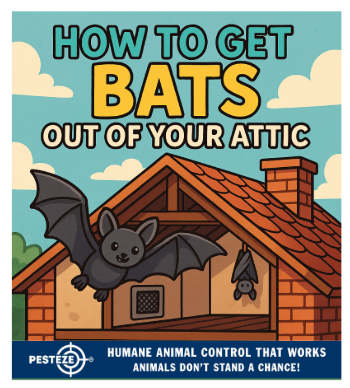HOW TO GET BATS OUT OF YOUR ATTIC

HOW TO GET BATS OUT OF YOUR ATTIC
SUMMARY
Bats play an important role in ecosystems, but having them in your attic can cause health and structural issues. This guide explains safe, humane, and legal methods to get bats out of your attic, prevent re-entry, and protect both your home and the animals.
FEATURES
-
Inspect entry points: Identify small gaps, vents, or cracks where bats enter.
-
Use exclusion devices: Install one-way bat valves that let bats exit but not return.
-
Time removal correctly: Avoid bat maternity season when young are unable to fly.
-
Avoid harmful methods: Never use poisons, traps, or sealing while bats are inside.
-
Seal after exit: Close all entry points permanently once bats are gone.
-
Hire professionals: Wildlife control experts ensure safe, legal removal.
GUIDE DESCRIPTION
Bats are valuable to the environment because they consume large numbers of insects, including mosquitoes. However, when they roost in your attic, problems arise. Bat droppings (guano) can accumulate quickly, creating foul odors, structural damage, and potential health risks such as histoplasmosis. While it’s understandable to want them gone, removal must be handled carefully to protect both the bats and your household.
The first step is inspecting entry points. Bats can squeeze through gaps as small as half an inch. Common access points include vents, soffits, chimneys, and gaps along the roofline. Conduct inspections at dusk, when bats leave to feed, to spot their flight paths.
Once you locate entry points, install exclusion devices such as one-way bat cones, tubes, or netting. These allow bats to exit but prevent them from returning. This is the most humane and effective way to clear bats from your attic. It’s important to ensure that all other potential openings are sealed before installing exclusion devices, so bats only have one way out.
Timing is critical. Never attempt bat exclusion during maternity season, typically late spring to mid-summer, when baby bats (pups) cannot fly. Sealing at this time can trap young bats inside, leading to inhumane deaths and even greater problems inside your attic. The best times for exclusion are early spring or late summer through early fall.
It is equally important to avoid harmful methods. Poisons, glue traps, and fumigation are not only cruel but also illegal in many areas. Killing bats can lead to legal penalties, as most species are protected by law. Instead, humane exclusion ensures bats are unharmed while keeping your home safe.
Once bats have vacated, you must seal all entry points. Use durable materials such as metal mesh, caulk, or heavy-duty sealants to close gaps permanently. Without this step, bats or other animals may return. Additionally, safely clean and disinfect areas contaminated with guano to remove health hazards.
In many cases, it’s best to hire professional bat removal services. Trained experts understand local regulations, know the right timing, and have specialized equipment to complete the job thoroughly and safely.
By following these humane and legal steps, you can remove bats from your attic, protect your home, and continue to respect the ecological importance of these animals.
- Saneeth Thota


Comments 0